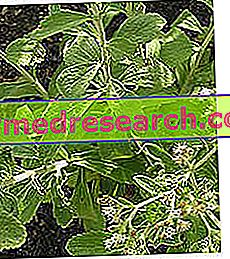Watch the video
X Watch the video on youtubeWhat is that
What is a Clay Mask?
The clay masks represent an excellent support to the treatment of some skin diseases and, on the doctor's advice, can even be used as a complement to the therapy of acne or seborrhea. Not surprisingly, the anti-inflammatory and detoxifying properties make the clay a very useful aid for the treatment of dermatoses, in particular against the inflammation of pilo-sebaceous glands and hair follicles.

Loans
Uses of the Clay Mask in cosmetics
In beauty salons, clay face masks are required to meet the most diverse needs.
The most appreciated clay masks are undoubtedly those with a purifying and detoxifying action to fight acne, blackheads and boils. Again, these dermo-cosmetic preparations smooth and soften the skin by gently exfoliating it. Furthermore, a clay mask can also be useful as an adjuvant treatment in case of dermatosis and erythema (naturally, in these cases it is good practice to ask the doctor for a preventive consultation).
Finally, if applied on the legs, thighs, buttocks or belly, the clay masks can also be used to counteract cellulite and stretch marks.
Property
Properties of the Clay
If many know that clay masks are excellent remedies for oily skin, few are aware of their countless other properties.
In fact, in addition to the well-known dermo-purifying properties, the clay is also equipped with:
- Balancing and mineralizing properties, thanks to its high content of salts, ions and metals;
- Antiseptic properties;
- Anti-toxic properties (thanks to its strong adsorbent power);
- Healing properties;
- Deodorant properties.
Finally, we cannot forget the anti-wrinkle action exerted by the clay: for this reason, many women who are no longer young ask for it in anti-aging face masks.
Types of Clay
The term "clay" is used in a very general way to indicate a particular compound obtained from a mixture of substances of mineral origin associated with metals, ions and other substances of organic origin.
However, depending on its origin (lake, sea, etc.), its composition and the metals and ions it contains, the clay can take on different characteristics and be suitable for treating a certain type of skin or disorder rather than another. For example, based on the concentration of iron present and its state of oxidation, the clay can take on a different color: in this specific case, therefore, we can distinguish the green clay - rich in iron in the form of ferric ion (Fe3 + ) which exerts a marked purifying activity on the skin - from the red clay that contains iron in the form of ferrous ions (Fe2 +) and instead performs a more delicate purifying action.
The table below lists the main types of clay that can be used in the preparation of a mask and their main indications in the dermo-cosmetic field.
Type of clay used in the mask | Indication |
Green clay | Green clay masks are particularly suitable for acne. Green clay effectively absorbs toxins from the skin, purifying it in depth. |
White clay | The white clay masks, the most delicate of all, are recommended to soothe and soften the skin; therefore, they are suitable for sensitive skin. |
Red clay | Similar to the previous ones, the red clay masks are indicated for delicate and sensitive skin. |
Pink clay | By toning the skin, the pink clay masks give tone and liveliness to tired and opaque skins. Furthermore, this type of clay has excellent detergent properties. |
Bentonite, kaolin and Fuller's earth | Suitable for acneic and seborrheic skin |
Action mechanism
How Clay Masks act
Placed in contact with water, the clay forms a very dense and viscous mass similar to the mud that solidifies in about ten minutes. The precious minerals contained in the clay (silica, magnesium, iron, aluminum, calcium, etc.) are adsorbed by the skin which, in turn, gives up the toxins accumulated in the fabric: in doing so, the clay purifies the epidermis, stimulating at the same time the microcirculation. For this reason, after use, the clay masks must be thrown away.
Preparation
How to prepare a Clay Mask
Before preparing a clay mask, you need to get plastic or ceramic containers; those in metal are not recommended because they could alter the product. Even the spoons for mixing the clay paste should be made of wood: therefore avoid metal spoons.

The other functional substances can be added in this phase: during the addition of the active ingredients it is suggested to mix vigorously and continuously until a thick but sufficiently spreadable consistency is obtained. If the clay mask is too thick and dense, it is necessary to add more water to make it more fluid.
Please note
When the consistency of the clay mixture is too fluid, there is a risk that the mask will not adhere to the skin, negating the "purifying" effect
Application
How to apply a Clay Mask
Before proceeding with the application of the clay mask on the face, it is necessary to remove all traces of makeup from the skin using a specific cleanser and plenty of warm water. The clay masks in fact require an application on thoroughly cleansed and dry skins; for this reason, it is important to pay particular attention to facial cleansing.
The clay mask should be applied with a soft bristle brush or smeared with fingertips. The mask must adhere perfectly to the skin of the face, without being too irritating or particularly sticky. In general, the product is applied starting from the chin, to then cover the neck and the whole face except for the eye contour and the perimeter of the lips.
The clay mask should be removed from the skin as soon as the product dries. If the clay dries quickly, it is advisable to enrich - the next time - the mixture with vegetable oils or honey to avoid over-drying the skin.
To keep the skin soft, moisturized and radiant for as long as possible, after removing the clay mask, it is advisable to apply a generous layer of cream on the face (eg nourishing / emollient cream, anti-wrinkle cream, hyaluronic acid cream, anti-acne cream etc.).
Poultice
The term "cataplasm" refers to a type of mask with very soft clay, which must be applied to the skin in the form of a wrap. Normally, a cataplasm thin layer is spread on the skin no more than 2 cm thick; subsequently, the skin is wrapped with a cloth to limit as much as possible the evaporation of the water. By not covering the skin with the cloth, the water would evaporate excessively making the clay too abrasive. After a period of laying time varying from 15 to 25 minutes, the poultice - which must still be wet but compact - is removed. Clearly, for hygienic and functional reasons, the clay should not be reused.



